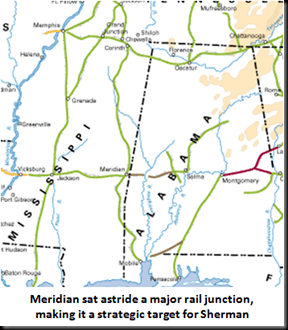26,847 Unknown Dates 14 Feb 1864 – 20 Feb 1864 | 170 Unknown Result Union victory | |
 | ||
Location Lauderdale County, Mississippi, United States Combatants Confederate States of America, Union Similar American Civil War, Jackson Expedition, Battle of Tupelo, Siege of Corinth, Battle of Jonesborough | ||
The Meridian Campaign took place from February 3–28, 1864, from Vicksburg, Mississippi to Meridian, Mississippi, by the Union Army of the Tennessee, led by Maj. Gen. William Tecumseh Sherman. Sherman captured Meridian, Mississippi, inflicting heavy damage to it. The campaign is viewed by historians as a prelude to Sherman's March to the Sea (Savannah Campaign) in that a large swath of damage and destruction was inflicted on Central Mississippi as Sherman marched across the state and back.
Contents
Background
After the 1863 Vicksburg Campaign, in which the Union army of Maj. Gen. Ulysses S. Grant succeeded in capturing Vicksburg and burning the state capital of Jackson, Union forces under Sherman turned eastward toward Meridian. Meridian was an important railroad center and was home to a Confederate arsenal, military hospital, and prisoner-of-war stockade, as well as the headquarters for a number of state offices.
Sherman planned to take Meridian and, if the situation was favorable, push on to Selma, Alabama, and possibly even threaten Mobile. While Sherman set out on February 3, 1864, with the main force of 20,000 men from Vicksburg, he ordered Brig. Gen. William Sooy Smith to lead a cavalry force of 7,000 men from Memphis, Tennessee, south through Okolona, Mississippi, along the Mobile and Ohio Railroad to meet the rest of the Union force at Meridian.
March to Meridian
To counter the threat, Confederate President Jefferson Davis ordered troops to the area from other localities. The Confederate commander in the area, Lt. Gen. Leonidas Polk, consolidated a number of commands in and around Morton, Mississippi, but lost his nerve and retreated rapidly eastward. On the journey towards Meridian, Sherman ordered several feints into other regions of the state to keep Polk guessing about Sherman's true point of attack. Sherman also asked Maj. Gen. Nathaniel Banks, Union commander of the Department of the Gulf at New Orleans, Louisiana, to have boats maneuvering in Mobile Bay as if they were preparing to attack. Doing this forced the Confederates to keep troops from leaving Mobile to aid Meridian in case of an attack on the gulf. To further confuse Polk, Sherman sent gunboats and infantry up the Yazoo River to divert his attention. Cavalry units commanded by Maj. Gen. Stephen D. Lee periodically skirmished with Sherman's force. As Sherman approached Meridian, he met stiffer resistance from the combined forces but steadily moved on. Polk finally realized that he could not stop Sherman and was convinced he was headed not for Meridian but for Mobile, so he decided to evacuate Meridian on February 14, fall back to Demopolis, Alabama, and prepare to launch a rear attack, leaving Meridian and its surrounding territory to the mercy of the enemy. While evacuating, Polk and his army began removing some railroad rolling stock to McDowell's Bluff.
Smith's troubles
Smith never reached Meridian; he and his troops met Confederate resistance led by Maj. Gen. Nathan Bedford Forrest at West Point, Mississippi. Forrest and his army forced Smith to begin to retreat to Tennessee. When Forrest saw Smith's army retreating, he ordered his troops to chase the army down. Forrest caught Smith and his troops in Okolona, Mississippi, and forced them to retreat more rapidly after a defeat in the Battle of Okolona on February 22, 1864, which ultimately resulted in General Sherman's entire left flank being eliminated during the campaign.
Destruction of Meridian
Sherman's army reached Meridian on February 14, 1864. Still unaware of Smith's defeat at West Point and the one to come at Okolona, Sherman decided to continue waiting for Smith in Meridian until the morning of February 20, when he gave up and returned to Vicksburg. While he and his army were waiting, Sherman ordered his troops "to wipe the appointed meeting place off the map" by destroying the railroads and burning much of the area to the ground. Sherman's troops destroyed 115 mi (185 km) of railroad, 61 bridges, 6,075 ft (1,852 m) of trestle work, 20 locomotives, 28 cars, and 3 steam sawmills. After the troops departed, inhabitants of the city were without food for some days, but the soldiers had not directly inflicted any personal injuries during the attack. After the destruction of the economic and military infrastructure of Meridian, Sherman is reported to have said, "Meridian with its depots, store-houses, arsenal, hospitals, offices, hotels, and cantonments no longer exists."
When Sherman left Meridian, heading west by way of Canton, Mississippi, he was still unaware of Smith's defeats, so he began looking for Smith and his force. He did not discover what happened to Smith until he arrived back at Vicksburg. Sherman had destroyed some important Confederate transportation facilities but had to abandon his aspirations for continuing into Alabama.
